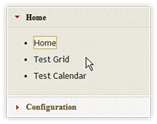Two-Level Navigation
The CorasWorks
Application Designer Solution v4 uses a special type of navigation, called
“Two-Level Navigation”. As the title implies, the navigation supports two
levels of navigation only.
 The first level is the tab
navigation. Within each tab is a buttons-based navigation. When a
user wants to go to a different page, they first click on a tab. A series
of buttons assigned to that tab are loaded. The user then clicks on the
appropriate button to load their page.
The first level is the tab
navigation. Within each tab is a buttons-based navigation. When a
user wants to go to a different page, they first click on a tab. A series
of buttons assigned to that tab are loaded. The user then clicks on the
appropriate button to load their page.
The tabs cannot
have a link to a page. Instead, the tabs serve as a container for their
buttons. In turn, the buttons cannot have any sub-buttons or menus.
When a button is clicked, a page is loaded. The navigation layout, as well
as color scheme and page security, is controlled by the Design Canvas.
By default, the
tabs and buttons are displayed on the left side of the page. Another
available option for the Two-Level Navigation is to have the tabs on the
right-side of the pages. This may be a better orientation within some
environments.
 There is also a completely
different type of navigation offered: Accordion Style. With this style,
the navigation is displayed vertically along the left side of the page.
When a user clicks on a container, the accordion section expands to show that
section’s options.
There is also a completely
different type of navigation offered: Accordion Style. With this style,
the navigation is displayed vertically along the left side of the page.
When a user clicks on a container, the accordion section expands to show that
section’s options.
To learn more about these options, as well as other
formatting options, please see the Design Canvas section.
Table 3: Note
On GUIDs
|
NOTE |
When a user loads a page within
their browser, the web address for the page includes a special identifier
in the URL. The browser will display a structure similar to the
following:
<<site>>/AppPages/MyPage.aspx?GUID=583d4034-662b-439b-8f62-0b998807d3c3-152
The GUID= and the identifier
that follows is required for the security of the pages. If a user
attempts to load a page without the GUID identifier, they instead load the
home page of the site. |
 The first level is the tab
navigation. Within each tab is a buttons-based navigation. When a
user wants to go to a different page, they first click on a tab. A series
of buttons assigned to that tab are loaded. The user then clicks on the
appropriate button to load their page.
The first level is the tab
navigation. Within each tab is a buttons-based navigation. When a
user wants to go to a different page, they first click on a tab. A series
of buttons assigned to that tab are loaded. The user then clicks on the
appropriate button to load their page.  There is also a completely
different type of navigation offered: Accordion Style. With this style,
the navigation is displayed vertically along the left side of the page.
When a user clicks on a container, the accordion section expands to show that
section’s options.
There is also a completely
different type of navigation offered: Accordion Style. With this style,
the navigation is displayed vertically along the left side of the page.
When a user clicks on a container, the accordion section expands to show that
section’s options.